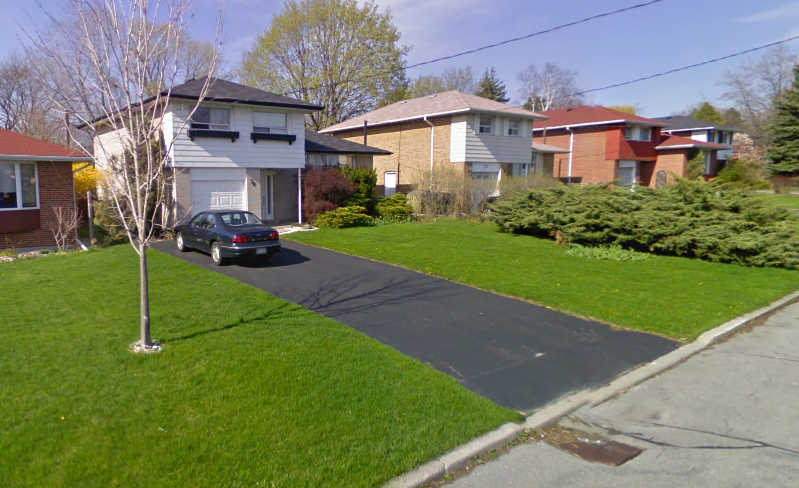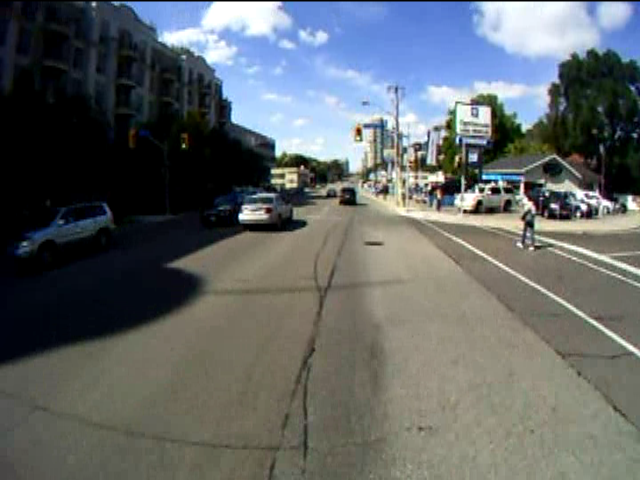Duke's - a making of a brand. A well-made short film, directed and edited by Jim Bachalo, about the Duke's Cycle bike shop that's been at 625 Queen Street West since 1914 (except for the short period following the fire that took down the whole building in 2008).
- 1 comment

Councillor Denzil Minnan-Wong lives in nice, quiet inner suburb of Toronto (not unlike the one pictured above). Note the lack of sidewalks. Note the lack of pedestrians. If you lived there you would likely drive to every place you needed to go. If you drove downtown you'd probably also see a stark difference between your quiet neighbourhood and the hustle and bustle of downtown. On downtown Toronto streets such as Jarvis and Dundas it's not as easy to drive what with all the pedestrians and cyclists. Compare that quiet suburb with the busyness of the pedestrian scramble at Yonge and Dundas:
If you lived in a quiet suburban house where everything was only reachable by car, perhaps you too would assume that all streets are built for cars and then reach the conclusion that downtown streets must also be changed to ensure that pedestrians and cyclists stay out of the way of your private automobile as much as possible. So perhaps it's not entirely surprising that Minnan-Wong sees pedestrian scrambles as a "problem" to be solved, or that cyclists need to be funneled onto certain streets so that other streets can be kept clear for drivers:
“Traffic along here is a real challenge. I’m not saying the scramble intersection is the complete problem,” Minnan-Wong says as he walked along Dundas St. on Thursday “Just a moment ago there was Pepsi truck making a drop off, when that happens, you turn a two-lane road into a one-lane. Then you double the time to clear the intersection and it really starts to add up.”
Minnan-Wong, in his role as Chair of the Public Works and Infrastructure Committee, has declared battle against congestion. He's directed City staff to do a "comprehensive" study of downtown traffic, the Downtown Transportation Operations Study
, to come up with quick ways to reduce congestion within the scope of the current road network. The study, which was born out of the Bikeway Network 2011 update which called for a pilot separated bike lane on Richmond, has since then suffered some scope creep. Not only has it expanded beyond its original northern boundary of Queen to include the pedestrian scramble at Yonge and Dundas, but it has also meant to come up with an inventory of quick ideas of reducing congestion in the whole downtown south of Queen. The pedestrian scramble, installed only a few years ago had already been recently studied and compared to the pedestrian scrambles in Calgary. That study was clear that there was a trade off between improving movement and safety for pedestrians with improving movement for drivers. Yes, a pedestrian scramble will make drivers slower but is that such a bad thing?
Funnily in the terms of reference of the Downtown Transportation Operations Study, City Staff has put all road users on equal footing, quite unlike what Minnan-Wong's comments are suggesting:
The primary focus is to identify opportunities that will initially improve traffic operations in downtown Toronto as quickly and as efficiently as possible. Initiatives that are low-cost, can be readily implemented, do not require extensive planning or design, do not require acquisition of private property, and can be supported by all road users will be given the highest priority. In addition, the study will also identify and review broader-scale changes that are likely to influence downtown traffic operations within the next ten-year period and identify opportunities for other medium and long term priorities.
The study terms sound reasonable, balancing the needs of all road users - pedestrians, public transit users, cyclists and drivers, noting that the Official Plan "clearly emphasizes a multi-modal approach with emphasis on transit and active modes and establishes the practical limitations of providing any substantive new road infrastructure capacity into the core".
My colleagues in the active transportation network aren't optimistic that the results of the study will be promising. First, it's unclear if making some quick tweaks will actually reduce car congestion; second, some of these tweaks may mean that cars are able to go faster - but faster cars result in greater danger for pedestrians and cyclists; third, road pricing seems to be off the table even though it has the greatest promise; and finally the politicians in power will likely cherry pick recommendations from the study to suit their focus on prioritizing car drivers.
It's pretty common knowledge that the city is full of cars; that there really isn't any room for more roads; and that new roads inevitably get congested rather than relieving it. The Mayor and his executive committee, however, seem not to understand the idea of induced demand, in that the easier we make it for private automobiles the more that extra space is just taken up with latent demand - people who otherwise would have avoided a trip because of the difficulty of traveling. There isn't money to build any new freeways into downtown nor money or space to build all the parking required. That won't stop some politicians from thinking that ideas like "synchronizing lights" as if the seconds saved will make a big difference for drivers. The worry is that the safety and convenience of people will get sacrificed again for the greediest transportation mode. And for nothing, since nothing short of making it harder for cars to drive on streets has ever "solved" the problem of car congestion without killing the patient in the process.
So does Minnan-Wong want a lively, safe city where cyclists and pedestrians feel comfortable? Or does he want to recreate his own quiet, tired neighbourhood across the city?

Motorists who harass cyclists, by honking, yelling at us, or buzzing us have no excuse. They don't even have the lousy excuse that we hold them up, because we don't. Motorists who harass cyclists do it because they can. They have a steel cage to protect them from the consequences of their behaviour, and an engine to run away. Other people suffer the consequences; often the most vulnerable of road users. To see an example of this, take a look at the accompanying video.
Let me put this plainly. If motorists, editorial writers, and others want to condemn cyclists who break the rules, they have a reciprocal obligation to come down on motorists to harass law-abiding cyclists. That means you, Globe writers who wrote that cyclists should "know our place". It means you, Star editors who devoted three stories to a cyclist who hit an elderly pedestrian in a fatal accident. It means you don't condone motorists who harass cyclist trying to follow the laws and cycle safely. It means you don't stay silent, either in person when they brag about how clever honking and yelling something unintelligible from inside a two-tonne steel cage makes them. It means you don't stay silent in print when you have an opportunity to promote safer roads.
- ‹ previous
- Page 85
- next ›
